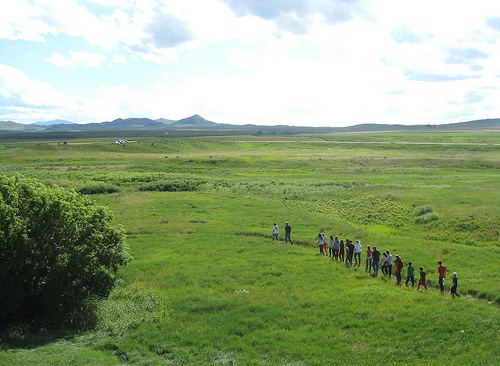

Location: Blaine County, Montana
Date: September 30- October 5, 1877
Bear Paw Battle site is a location of a Battle of Bear Paw that is situated in Blaine County, Montana. It was fought on September 30- October 5, 1877 between US cavalry under command of General Oliver Otis Howard and Colonel Nelson A. Miles and Nez Perce natives under leadership of Chief Joseph. Some of the Nez Perce managed to leave for Canada, but the leader Joseph with most of the tribe was forced to surrender to General Howard and Colonel Miles. Today, the battlefield is part of the National Historic Park of Nez Perce.
Department of the Columbia - Brigadier General
Oliver O. Howard
District of the Yellowstone - Colonel Nelson
A. Miles
Headquarters
Adjutant – 1st Lieutenant George W.
Baird
Aide-de-Camp – 1st Lieutenant Frank D. Baldwin
Engineer
– 2nd Lieutenant Oscar F. Long
Scouts – 2nd Lieutenant Marion M.
Maus
Surgeon – Major Henry R. Tilton
Assistant Surgeon – 1st
Lieutenant Edwin F. Gardner
7th U.S. Cavalry: Captain Owen Hale
Company A – Captain Myles Moylan
Company D – Captain Edward S.
Godfrey
Company K – Captain Owen Hale senior officer of
detachment
2nd U.S. Cavalry: Captain George L. Tyler
Company F
– Captain George L. Tyler senior officer of detachment
Company G
– 2nd Lieutenant Edward J. McClernand
Company H – 2nd Lieutenant
Lovell H. Jerome
5th U.S. Infantry: Colonel Nelson A. Miles
Company B – Captain Andrew S. Bennett
Company F – Captain Simon
Snyder
Company G – 1st Lieutenant Henry Romeyn
Company I – 1st
Lieutenant Mason Carter
Company K – Captain David H. Brotherton
Company D – attached to Company K
The Nez Perce had carried out an epic fighting
retreat for 1,170 miles across parts of four states, only to be
halted 40 miles from safety in Canada. Joseph had impressed the
entire nation with his campaign. Howard and Miles praised the Nez
Perce and even General William T. Sherman praised them for their
fighting ability and the relative lack of atrocities they committed.
Miles had promised Joseph that his people would return to
reservations in their homeland, but this promise was overruled by
Sherman. The Nez Perce were sent to Kansas and Indian Territory,
despite the protests of Howard and Miles. In 1885, the Nez Perce
were allowed to return to Washington but Joseph was refused
permission to live in his homeland in the Wallowa River Valley in
Oregon.
Joseph was an eloquent spokesman for his people,
well-known and respected by his old foes in the U.S. Army and by the
American public. He died on September 21, 1904, on the Colville
Indian Reservation in Washington. His doctor said he died of a
broken heart.